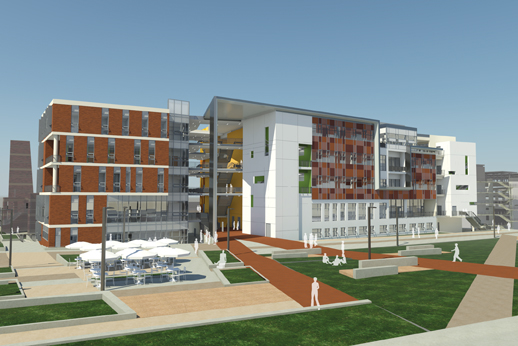California is a breeding ground for building information modeling and integrated project delivery. Major healthcare owners such as Sutter Health and Kaiser Permanente have reaped huge savings from using BIM in the design stage and co-locating their Building Teams early in the process. These efforts pale in comparison to the massive scale of BIM and integrated delivery requirements of the Los Angeles Community College District.
LACCD is currently undergoing a $6 billion construction program on all nine of its campuses throughout Los Angeles County, the most populous county in the U.S. (2010 Census: 9,818,605). To win any of the design-build contracts for new buildings or retrofits, Building Teams must agree to a rigorous BIM program that demands compliance with strict rules on workflow, information sharing, and early design collaboration. The requirements are spelled out in considerable detail. A typical example: “For Spatial Coordination, BIM Facilitator will integrate the design discipline and trade-specific models into a consolidated 3D-model using coordination software.”
Under LACCD’s BIM/IPD procedures, Building Teams must name a lead facilitator to coordinate BIM workflow on behalf of the architect, engineer, or design-build contractor for the entire duration of the project. There are specific requirements for shared data servers and detailed standards for project kickoff orientation meetings. There’s even a stipulation that the designer provide a virtual theater for viewing of 3D models by the entire Building Team.
Design and construction firms that want to work with LACCD must not only agree to the District’s BIM/IPD requirements (http://standards.build-laccd.org/projects/dcs/pub/BIM%20Standards/released/content.html) and modeling standards as a condition of employment, they must also submit to project tracking on LACCD’s BIM project website and agree to turn over their BIM models at the end of construction to LACCD for the owner’s use in managing the facilities.
“We focus on the life cycle of a building,” says Jim Youngblood, the LACCD’s BIM and virtual design and construction manager. “We want anyone working on a project for us to know the importance of the big picture,” Youngblood says that throughout the history of LACCD’s Sustainable Building Program, design and construction consultants have asked him, “Is modeling to this level truly that important and useful to you?” His response: “It is, because we will be using this data for the entire life of these buildings.”
BuildLACCD dates back to 2001, when Los Angeles County voters approved the first of three successive bond measures providing the bulk of the program’s $6 billion in funding. While modernizing the nine colleges was the main priority of the program, LACCD has also used the program to focus on cutting-edge green building techniques, and it has won several awards for its sustainable construction practices. Youngblood says embracing BIM technology is another crucial step toward the LACCD’s sustainability and cost-efficiency goals.
To help design-build teams new to the technology get their footing, BuildLACCD has created its own blog, http://bimlaccd.blogspot.com/, to share success stories, get the word out about BIM workshops run by the LACCD, offer other training opportunities, and share news about of the latest Southern California BIM news.
Youngblood, LACCD BIM manager Michael Cervantes, who oversees the entire LACCD BIM program with assistance from Youngblood, and LACCD BIM designer Giovana Romero are all “active” owners who make a point of attending Building Team meetings for LACCD projects to make sure the BuildLACCD process is being carried out. They recognize, however, that simply requiring BIM and integrated project collaboration is one thing, but following through on such a sophisticated set of requirements is another.
Following are two case studies that give a feel for how BIM is being implemented in LACCD projects.
LOS ANGELES HARBOR COLLEGE—DESIGNING FOR CONSTRUCTABILITY
The Los Angeles office of HGA Architects and Anaheim-based Pinner Construction are the design-build team behind a new 73,767-sf, three-story Science Complex for LA Harbor College. When it’s completed next year, the new complex will consist of two L-shaped, steel-frame structures set perpendicular to each other: a three-story east wing housing laboratories, and a two-story west wing housing lecture halls, classrooms, and offices. The wings are connected via a bridge over a walkway. The L-shaped orientation addresses a primary campus entrance from the parking area, directing pedestrian circulation through the site.
In pursuit of a LEED Platinum rating from the U.S. Green Building Council, HGA and Pinner have developed a strategy that includes self-generation of energy striving to achieve net-zero energy, a 42% energy reduction over California’s Title 24 baseline, 57% water use reduction, and 36% energy self-generation from building-integrated photovoltaic panels. Such a complex building likely would have required BIM and energy modeling in the design stage, even if LACCD didn’t require them.
“It would have been very difficult without Navisworks for clash detection in the first place,” says Matthew Dunbar, HGA’s BIM coordinator on Harbor College. “Pinner Construction’s superintendents went through the Navisworks models with everyone else and flagged areas for constructability and worked with us early in design. That was feedback we wanted and needed.”
Dunbar says the team had frequent meetings via WebEx to go over the shared Navisworks model and got input from subcontractors on how the design model could be used for constructability. He says having a BIM program that forced the entire Building Team to meet and validate their results was helpful in getting the design finalized.
“LACCD was one of the first clients we had that had a standardized process they wanted us to walk through,” he says. “Having done projects before where we had owners who have no idea what we’re doing, or ones who just see dollar signs from BIM, it’s nice to have someone who provides a framework. It was immensely helpful to have this process define what you’re doing.”
James Matson, a principal with HGA’s Los Angeles office, says, “On the design side, the work effort occurs earlier in the process. A well-coordinated team of designers and subcontractors is crucial to making the right design decisions early. This coordinated design effort allows the contractor to begin shop drawings earlier.”
While there was feedback from contractors and subcontractors in the design stage, a new model expressly built for constructability was still needed to go from design to construction.
“We’re adding things that the design side doesn’t think about,” says Roger Charbonneau of AEC Factory, Torrance, Calif., the BIM modeler for Pinner Construction on Harbor College. These neglected components include hangers, bracing, and deck inserts, which AEC Factory added to the construction model and exported out to CAD; from there, the construction team put those components into a Trimble field layout system before construction. “On the design side there are still things that need coordination once the design model is turned over—things like pipe clearances, fireproofing, light-gauge steel,” says Charbonneau. “We’re doing all of that before we get to the field. At the end of the day, the design model and construction model are different.”
Earlier projects at LACCD have even had facilities managers involved. Both mechanical and plumbing subcontractors have done serviceability walks with the facilities system foreman who will ultimately receive the building. This is a system-specific walkthrough, floor by floor, done in Navisworks, Bentley Navigator, or some other BIM navigation program before construction begins.
Theoretically, RFIs and change orders should not occur on LACCD projects, since all Building Team members are coordinating early in the design process. Nonetheless, says Charbonneau, there is still a certain degree of apprehension among Building Team members with making so many crucial decisions so early in the process.
“In design-build we’re on the same side, but that’s not the case in all projects,” Charbonneau says. “Anything we can automate or prefabricate on the construction side is saved money.” The same is not necessarily true on the design side, he says. “In design, those savings aren’t really quantifiable yet. What is saved design time worth?” he asks.
EAST LOS ANGELES COLLEGE—ENCOURAGING STUDENT-FACULTY COLLABORATION
HGA and Pinner’s latest project for the LACCD is the Student Success and Retention Center, a 130,000-sf, $55 million, five-story classroom, office, and language lab building for East Los Angeles College. It consolidates nine departments into a flexible learning environment that encourages collaborative student-faculty interaction while incorporating sustainable strategies to achieve LEED Gold and net-zero energy consumption. Design was recently completed; the scheduled opening is early 2014.
A key to winning this project was keeping the entire HGA/Pinner design-build team together, including subcontractors. The collaboration and early modeling efforts that were pioneered on Harbor College paid off on this project. “Everyone comes back into place and is more efficient,” says HGA’s Dunbar. “We knew the LACCD process better on this one, and that’s really a roadmap for all these projects.” The HGA/Pinner team is competing for a third LACCD project.
“An owner is forcing its teams to work in BIM the way they want them to, and they have $6 billion dollars in new work,” says the AEC Factory’s Charbonneau. “Every player in the team has to be involved. You have a lot of old dogs who don’t want to change, but if they’re on one of these projects they have to. The high-performance team is really hitting its stride on East LA College.” BD+C
BD+C Contributing Editor Jeff “BIMBoy” Yoders blogs on BIM and related design/construction IT topics at www.BDCnetwork.com
Related Stories
Mixed-Use | Jan 19, 2024
Trademark secures financing to develop Fort Worth multifamily community
National real estate developer, investor, and operator, Trademark Property Company, has closed on the land and secured the financing for The Vickery, a multifamily-led mixed-use community located on five acres at W. Vickery Boulevard and Hemphill Street overlooking Downtown Fort Worth.
Modular Building | Jan 19, 2024
Building with shipping containers not as eco-friendly as it seems
With millions of shipping containers lying empty at ports around the world, it may seem like repurposing them to construct buildings would be a clear environmental winner. The reality of building with shipping containers is complicated, though, and in many cases isn’t a net-positive for the environment, critics charge, according to a report by NPR's Chloe Veltman.
Sponsored | BD+C University Course | Jan 17, 2024
Waterproofing deep foundations for new construction
This continuing education course, by Walter P Moore's Amos Chan, P.E., BECxP, CxA+BE, covers design considerations for below-grade waterproofing for new construction, the types of below-grade systems available, and specific concerns associated with waterproofing deep foundations.
Sponsored | Performing Arts Centers | Jan 17, 2024
Performance-based facilities for performing arts boost the bottom line
A look at design trends for “budget-wise” performing arts facilities reveals ways in which well-planned and well-built facilities help performers and audiences get the most out of the arts. This continuing education course is worth 1.0 AIA learning unit.
Adaptive Reuse | Jan 12, 2024
Office-to-residential conversions put pressure on curbside management and parking
With many office and commercial buildings being converted to residential use, two important issues—curbside management and parking—are sometimes not given their due attention. Cities need to assess how vehicle storage, bike and bus lanes, and drop-off zones in front of buildings may need to change because of office-to-residential conversions.
MFPRO+ News | Jan 12, 2024
Detroit may tax land more than buildings to spur development of vacant sites
The City of Detroit is considering a revamp of how it taxes property to encourage development of more vacant lots. The land-value tax has rarely been tried in the U.S., but versions of it have been adopted in many other countries.
MFPRO+ News | Jan 12, 2024
As demand rises for EV chargers at multifamily housing properties, options and incentives multiply
As electric vehicle sales continue to increase, more renters are looking for apartments that offer charging options.
Student Housing | Jan 12, 2024
UC Berkeley uses shipping containers to block protestors of student housing project
The University of California at Berkeley took the drastic step of erecting a wall of shipping containers to keep protestors out of a site of a planned student housing complex. The $312 million project would provide badly needed housing at the site of People’s Park.
Apartments | Jan 9, 2024
Apartment developer survey indicates dramatic decrease in starts this year
Over 56 developers, operators, and investors across the country were surveyed in John Burns Research and Consulting's recently-launched Apartment Developer and Investor Survey.
K-12 Schools | Jan 8, 2024
Video: Learn how DLR Group converted two big-box stores into an early education center
Learn how the North Kansas City (Mo.) School District and DLR Group adapted two big-box stores into a 115,000-sf early education center offering services for children with special needs.
















